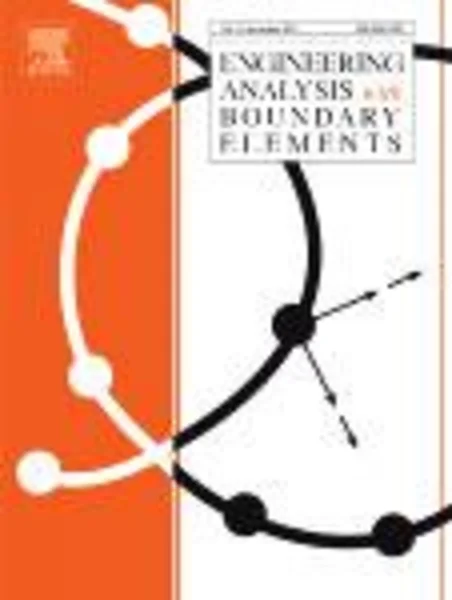-
evaluation of free terms in hypersingular boundary integral equations
جزئیات بیشتر مقاله- تاریخ ارائه: 1390/01/01
- تاریخ انتشار در تی پی بین: 1390/01/01
- تعداد بازدید: 515
- تعداد پرسش و پاسخ ها: 0
- شماره تماس دبیرخانه رویداد: -
the accurate numerical solution of hypersingular boundary integral equations necessitates the precise evaluation of free terms, which are required to counter discontinuous and often unbounded behaviour of hypersingular integrals at a boundary. the common approach for the evaluation of free terms involves integration over a portion of a spherical shaped surface centred at a singularity and allowing the radius of the sphere to tend to zero. in this paper two alternative methods, which are shape invariant, are proposed and investigated for the determination of free terms. one approach, the point-limiting method, involves moving a singularity towards a shrinking integration domain at a faster rate than the domain shrinks. issues surrounding the choice of approach and shrinkage rates, and path dependency are examined. a related approach, the boundary-limiting method, involves moving an invariant but shrinking boundary toward the singularity again at a faster rate than the shrinkage of the domain. the latter method can be viewed as a vanishing exclusion zone approach but the actual boundary shape is used for the boundary of the exclusion zone. both these methods are shown to provide consistent answers and can be shown to be directly related to the result obtained by moving a singularity towards a boundary, i.e. by comparison with the direct method. unlike the spherical approach the two methods involve integration over the actual boundary shape and consequently shape dependency is not a concern. a particular highlight of the point limiting approach, as a result of field approximations being restricted to the boundary, is the ability to obtain free terms in a mixed formulation without reference to the underpinning constitutive equations, which is not available to the spherical method. focus in the paper is on the 2-d potential equation as this is shown to be sufficient to demonstrate the concepts involved.
مقالات جدیدترین رویدادها
-
استفاده از تحلیل اهمیت-عملکرد در ارائه الگوی مدیریت خلاقیت سازمانی و ارائه راهکار جهت بهبود
-
بررسی تاثیر ارزش وجوه نقد مازاد بر ساختار سرمایه شرکت های پذیرفته شده در بورس اوراق بهادار تهران
-
بررسی تأثیر سطح افشای ریسک بر قرارداد بدهی شرکت های پذیرفته شده در بورس اوراق بهادار تهران
-
بررسی تأثیر رتبه بندی اعتباری مبتنی بر مدل امتیاز بازار نوظهور بر نقد شوندگی سهام با تأکید بر خصوصی سازی شرکت ها
-
تأثیر آمیخته بازاریابی پوشاک ایرانی بر تصویر ذهنی مشتری پوشاک ایرانی (هاکوپیان)
-
شبیه سازی جریان حلقوی گاز-مایع در میکروکانال tشکل با استفاده از دینامیک محاسباتی سیالات
-
بررسی عوامل و موانع انجام کارهای پژوهشی و تحقیقاتی از دیدگاه اعضای هیئت علمی
-
تاثیر آموزش ذهن آگاهی نوجوان محور بر افسردگی و اضطراب دختران دارای شکست عاطفی
-
co-delivery of sox9 genes and anti-cbfa-1 sirna coated onto plga nanoparticles for chondrogenesis of human mscs
-
compressibility and shear compliance of spheroidal pores: exact derivation via the eshelby tensor, and asymptotic expressions in limiting cases
مقالات جدیدترین ژورنال ها
-
مدیریت و بررسی افسردگی دانش آموزان دختر مقطع متوسطه دوم در دروان کرونا در شهرستان دزفول
-
مدیریت و بررسی خرد سیاسی در اندیشه ی فردوسی در ادب ایران
-
واکاوی و مدیریت توصیفی قلمدان(جاکلیدی)ضریح در موزه آستان قدس رضوی
-
بررسی تاثیر خلاقیت، دانش و انگیزه کارکنان بر پیشنهادات نوآورانه کارکنان ( مورد مطالعه: هتل های 3 و 4 ستاره استان کرمان)
-
بررسی تاثیر کیفیت سیستم های اطلاعاتی بر تصمیم گیری موفق در شرکتهای تولیدی استان اصفهان (مورد مطالعه: مدیران شرکتهای تولیدی استان اصفهان)
-
بررسی تاثیر توانایی مدیریت بر رابطه بین کیفیت حاکمیت شرکتی و عملکرد سرمایه فکری
-
تاثیر نظارت و بازرسی در صنعت بیمه بر سطح رضایتمندی مشتریان: مطالعه موردی شرکت بیمه آسیا
-
ارزیابی و رتبه بندی ابعاد بازاریابی رابطه مند بررضایت مشتریان در صنعت بیمه با استفاده از تکنیک ahp-fuzzy
-
علل و انگیزه های بزهکاری نوجوانان و رابطه معنادار ویژگی های تربیتی و روانی
-
بررسی تاثیر کارایی سرمایه فکری بر استراتژی شرکت های پذیرفته شده در بورس اوراق بهادار تهران




سوال خود را در مورد این مقاله مطرح نمایید :